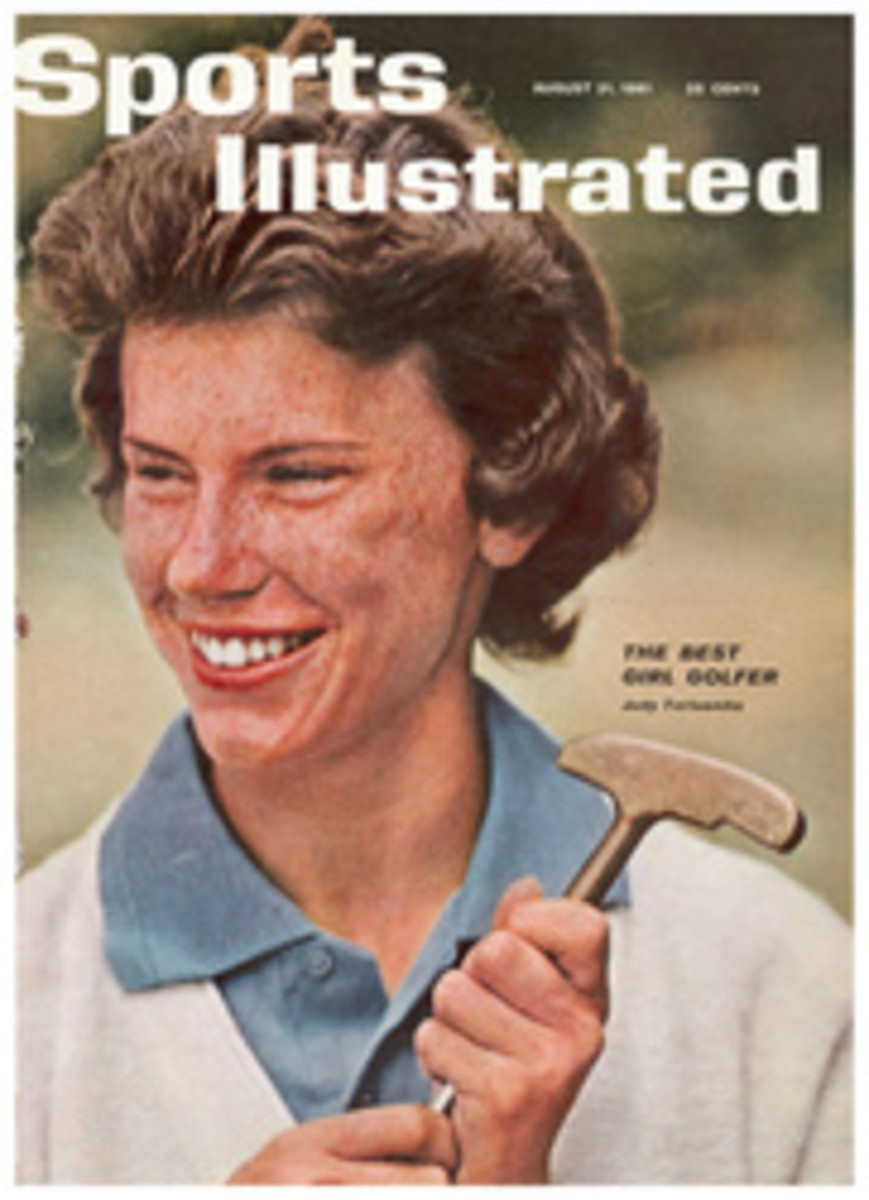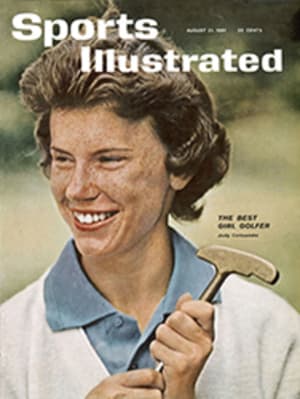
Everything but a Horse
Miller's, an egalitarian New York equestrian establishment that makes no distinction between man and beast, claims that it carries 1) everything for the horseman and 2) everything for the horse. This assertion is perfectly true (Miller's catalog lists everything from jodhpurs to jowl hoods), and the store is entitled to do a bit of boasting about it. Nonetheless, there is one item of merchandise that Miller's does not carry and that is the horse itself.
Joe Miller, the store's president, recalls the day he made this decision. "It was in the mid-1940s," he says, peering owlishly over his horn-rim glasses. "Carriages were selling very well—gasoline was rationed—and we were also selling the horses to pull them." A dealer called Miller up and said, "Joe, I've got a horse your customers will love, a horse a little girl can drive." Miller went to the man's stable, took one look at the animal and felt like going home. "His eyes were rolling in two different directions. He nearly kicked two grooms to death while they were hitching him up." Miller and the dealer had barely gotten into the carriage when the horse bolted, galloping right into Central Park. "He's a little high-spirited," the dealer yelled.
It was a holiday weekend, and the park was thronged with people. "The horse scattered them in all directions," says Miller. "Cops blew their whistles and kids ran after us yelling 'Hi yo, Silver!' " The horse circled the park, galloped back to the stable and Miller stepped down shakily. "Joe," the dealer told him, "you don't want this animal." "Where'd you get that idea?" Miller replied, wiping his brow. "Joe," the dealer said, "the horse is a sweetheart, but the two of you just don't hit it off."
Then and there Miller decided to concentrate on saddlery, tack and apparel, and let the store's customers get their own horses. Today, as a result, he presides over a merchandising operation on Manhattan's East 24th Street that does a $2 million annual business. "And you know something?" he says happily. "Carriages still sell. One fellow once bought 14, including a four-horse brougham." The customer, Miller adds, was "the Vice King of Phenix City, Ala., and proud of it." Every Sunday morning, weather permitting, he'd load his girls into the carriages and parade them around town. "The fresh air," says Miller, "did wonders for their complexions."
Be this as it may, the bulk of Miller's trade is more traditional. Polo mallets are shipped to Dhahran, Saudi Arabia; electric horse clippers to Holliston, Mass.; super never-rust racking bits to San Antonio. "What's more," Miller points out, "we're continually improving equipment. We've just developed a new sulky wheel that, over the next decade, may bring us a million dollars in orders." Present sulky wheels, he explains, are like bike wheels; they have a dozen or more parts, and every few weeks they must be laboriously taken apart and cleaned. The new wheel has a one-piece hub with a sealed bearing; no involved cleaning is necessary.
"With it all," says Miller, "we're a personal store. Little girls write us chatty letters. 'Dear Mr. Miller,' they'll say, 'Annie—that's my horse—has a bad cold. Mother thinks she's sweating too much under your 375 Stable Blanket. What do you think?' Or sometimes they'll write, 'Dear Mr. Miller: My horse coughs all the time. Mr. John, the groom, says to give him cod-liver oil. I don't like cod-liver oil myself, and maybe my horse won't. What should I do?' "
A typewritten manuscript was lying on Miller's desk, and he picked it up. "We're even in the literary business," he said. "No publisher would touch a horse book without consulting us first." He flipped through the pages. "Here's the outline of a manual called Horse Owners' Hoof Care. It explains how to shoe. Do-it-yourself is getting more and more popular." Finally, Miller paused for breath. "There's nothing the horseman needs," he said flatly, "that we don't have. Go ahead, take a look around."
On Miller's first floor, in the apparel department, signs announced a clearance sale on ladies' felt riding hats (in assorted colors, $2.50) and a special on Helanca stretch-cloth breeches ($50). A spare, spry man in his 50s clambered astride a saddle atop a chest, where he was fitted for a pair of jodhpurs. Waiting to follow him were four young ladies, in graduated sizes, whose mother complained they were all growing out of their jodhpurs together. A crayoned placard on the wall, obviously drawn by an adolescent, reassured her. "Twas the day 'ere the show," it declaimed, "and we were in a tizzy. But Miller's products made us all much less busy."
A Miller's representative named Marc Elfant proceeded to display the five-story building's wares. An Argentinian by birth, Elfant is a trim, ebullient man. "We have saddles from England, from Germany, from France," he said. "An expert can tell where a saddle comes from just by glancing at it." He hefted an incredibly light racing saddle. "It only weighs one pound." A small machine with a vacuum-cleaner-type attachment drew his attention. "This is an Electro-Groom. It's excellent for people who have small stables." There were veterinary preparations as well. Miller's Skin Conditioner was the exact color of good bourbon; Chevinal, a vitamin-mineral supplement, contained brewer's yeast, wheat germ and skim milk.
"The bulk of our business," said Elfant, "is in English apparel and saddlery. But western accounts for 15%." He pointed toward the racks of western clothing. "Frontier pants, Levis, fringed jackets." An ornamental saddle was selling for $650. "We've sold silver saddles for $10,000. Good silversmiths are hard to find; the saddles are an investment."
Two-thirds of Miller's business is mailorder. "That's why we keep so much stock on hand," said Elfant. He walked over to a box of gleaming white helmets and picked one up. "This is a plastic helmet we developed that's mandatory for exercise boys. It's in the morning at the tracks that most accidents happen—when the boys are working the horses. We also make a variation, a helmet that's covered with velvet, for fox hunting." (A Warrenton, Va. huntswoman who survived a bad spill testifies to the helmet's worth in Miller's catalog. "The horse left the print of her shoe on the velvet," the satisfied customer writes, "but the hat was not even dented.")
Elfant held up two saddles. "See, one has a flat seat for riding saddle-bred horses, the other a deep seat for polo." He gestured toward a box of seat sticks. "The country squire can take his leisure while watching the races." Elfant picked up a combination walking and measuring stick. "The country squire uses it as a cane, and when he wants to know how fast one of his colts is growing he pulls out the measure. One side for centimeters, the other for hands." An old, dusty horse collar was lying in the corner. "Someone will want it," said Elfant, "and we'll dust it off." He unfolded a rectangular piece of hide. "We even have blacksmiths' aprons." Near by was a bent piece of wood that resembled a backscratcher. "It's a sweat-scraper," Elfant explained.
For years, Miller's has found Army surplus extremely profitable. Fifteen years ago, when the U.S. Cavalry was being disbanded, the store began buying enormous quantities of equipment. Elfant motioned toward a saddlebag. "We bought 6,000 of them. Everyone thought we were crazy. Now we've sold them all, except for a dozen or so we keep as mementoes." He put his hand on a saddle. "This is known as a McClellan saddle. We must have bought 20,000, and sold each of them for $15. Now we've run out." (The original Army saddlebags and saddles are gone, but their popularity is such that Miller's sells modern-day copies. Unfortunately, their prices are also modern-day: they're three times as high.)
Miller's riding-apparel department is run by Jack Miller—Joe's brother. A careful craftsman, Jack sports both a mustache and a beard, and he has definite ideas about riding clothes. "Most people think the looser the better," he says. "That's wrong. Riding clothes must be tight." He put aside his tape measure. "The old English breeches makers used to say, 'If you can get them on, they're too big.' That's not too exaggerated. Tight breeches protect against chafing." Moreover, says Miller, riding apparel must be heavy. "It takes quite a beating. The best breeches, for instance, are made of 34-ounce fabric, as compared to the 12-ounce fabric in an ordinary pair of trousers."
The cost of riding clothes, Jack Miller emphasized, is steadily going down. "A pair of custom-made breeches may sell for $150," he said, "but a pair of ready-mades may cost as little as $10." A riding jacket, he added, sold 12 years ago for $75; now, with improved production methods and increased demand, it sells for as little as $30. And a child's hunt cap, which sold for $35, now costs only $13.50. Nonetheless, readymade clothing is not ill-fitting clothing. "Our ready-made breeches," he said, "come in sizes that vary for each inch of waistline. Moreover, they have five inseam lengths."
Basically, Jack Miller explained, there are three types of English riding apparel. One is worn for saddle seat (e.g., horse shows), the second for jumping or hunting, and the third for hacking or park riding. "For saddle seat," said Miller, "you wear a coat and trousers that match or contrast. For informal jumping or hunting, you wear a tweed coat and breeches; for formal jumping or hunting, a black coat and yellow breeches, or the hunting pink. For hacking, you may wear cuff-bottom jodhpurs with a contrasting coat or sweater, and jodhpur shoes." There are, of course, many variations within this framework. "The saddle-seat jodhpur, for instance, has its flair at the bottom, around the ankles. Hunting breeches have their flair at the sides, around the thighs." This is a matter of practicality, as hunting riders use a shorter stirrup than the saddle-seat rider and need more freedom. Hats are equally practical. In saddle seat, an ordinary felt hat can be worn—a porkpie, a fedora, a roller. In hunting, since the rider is in some danger, he wears a hunt cap—a helmet of unbreakable plastic that's covered with velvet—or a hunt derby. Even the stock tie's origin was utilitarian. In an emergency, it could be used as a bandage and fastened with its long gold pin.
It was nearly noon, and Miller's began to crowd with customers. The merits of saddles and blankets and jodhpurs were discussed in quiet, earnest tones. It brought to mind an anecdote Joe Miller had related earlier. One of his favorite customers was a white-haired dowager who visited the store every spring in a chauffeur-driven limousine—with a horse trailer hitched behind. The woman would lead the horse into the store, and he would be fitted for a new outfit. "She was a wonderful person," Miller said. "She always brought me fresh milk and butter from her farm." Only one thing had upset him. A newsman had elaborated on the story a bit, reporting that the woman had ridden the horse in. "Naturally," Miller said, "she wouldn't have done that. There's all the difference, you see, between leading a horse into a store and riding one in."
PHOTO
TONY TRIOLO
PRETTY EQUESTRIENNE IS FITTED FOR PAIR OF JODHPURS BY MILLER'S MARC ELFANT
PHOTO
TONY TRIOLO
LEAD STRAPS FLOW IN ENDLESS STREAM
PHOTO
TONY TRIOLO
SADDLE GETS FINAL TOUCH FROM EXPERT
PHOTO
TONY TRIOLO
MAILROOM HANDLES WORLDWIDE ORDERS

